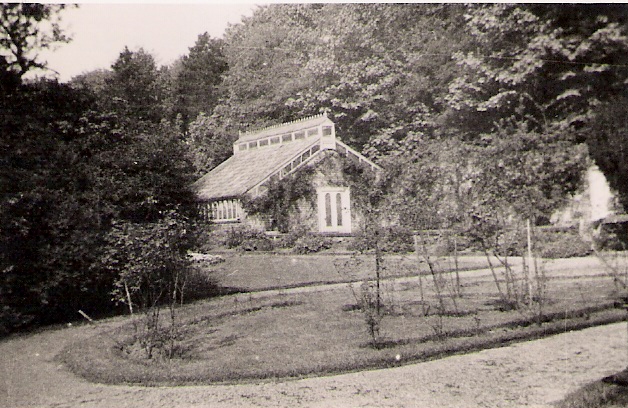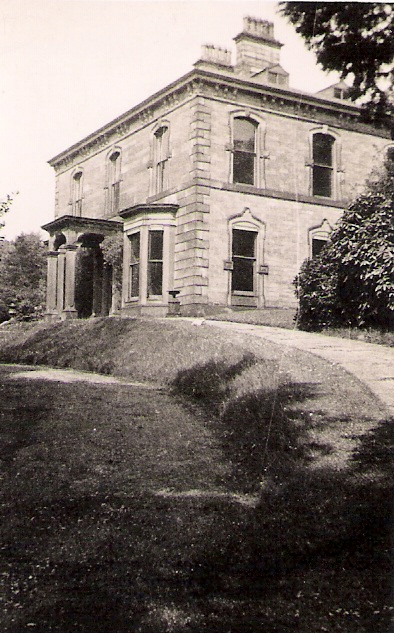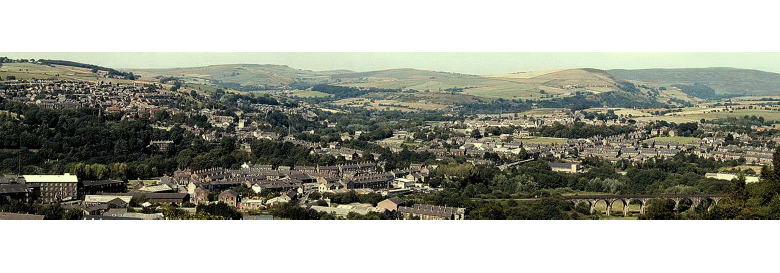| | | | |  | |  | | | |
Birch Vale House
Birch Vale House was once a fine and unique house. The Bennett’s, who
came from Charlesworth, (their graves are in the chapel above Charlesworth
on the road to the Grouse) started the Print Works, originally at the Garrison,
and they lived in a small house between the Garrison and the Birch
Vale/Thornsett road. They then built Birch Vale Print Works in about 1841
(date on the first chimney, the second chimney was dated 1851), in what was
then Spinnerbottom, but they changed the name to Birch Vale.
The print works flourished, printing mainly, but not entirely, calico (cotton) until the American Civil War (1861- 1865) when for a few years cotton was no longer available.
However Great-grandfather Bennett (John b.l816 ) had a good reputation for
business so he had no difficulty in borrowing money from the bank (unlike
Great-grandfather Hadfield (John b.l806 ) of Cowbrook, Glossop who could
not borrow, but was lent money to start up after the Civil War was over, from a
friend, only on the condition, as well as a high rate of interest, that he restart
when and only when the friend told him to!)
Great-grandfather Bennet borrowed money as did many other cotton manufacturers in Lancashire and South Yorkshire, to keep his workforce from
starving, and keep them busy, (for instance paving the Pennine Way at Mankinholes.) Great-grandfather Bennett set up a soup kitchen, so that no-one in Birch Vale suffered malnutrition, in return (without wages!) the work force
built Birch Vale House.
Birch Vale House was a beautiful house, with plenty of free labour the stone
was smoothed. The woodwork - the parquet floor in the big drawing room and
the stairs and banisters, had no metal nails, they were all held by wooden dove
tails, and the enormous sash window halfway up the stairs, which must have been, on the bottom half about 4ft.x 6ft. was so perfectly balanced that one could open it with one's little finger. The drawing room, a very large room, thesize of two large rooms, had a partition "hidden' in the ceiling between the tworooms so that it could be converted to two rooms if desired. The green baize
door leading from the hall to the kitchen passage was balanced perfectly so
that anyone carrying a tray could open it with an elbow, either way and then
have the door swing to gently after them. The cornices in the drawing room
were decorated in gold leaf, and it was a very large room with a very elaborate
cornice. There was central heating, radiators in the main rooms, but under
floor heating, pipes below a metal grid in the billiard room where one could
stand to play billiards. On the ground floor there was the dining room, with a
hatch to the kitchen, and the very large drawing room, there was also a billiard
room and a large kitchen. The way in from the garden to the billiard room had
a wash basin and lavatory off it and for the maids there was an outside lavatory
across the back yard. On the first floor there were five bedrooms, and two
bathrooms and lavatories. In the attic there were many smaller bedrooms.
The gardens must have been spectacular. There was, altogether, 26 acres, most
of it woodlands with some fields. More formally all along the long drive there
was a narrow strip of lawn on both sides, and then a double row of rhododendrons.
There was also the "rhododendron path” used as a short cut to the main
road and the railway station, with again a double row of rhododendrons on either side of it. On one side of this was a large orchard and on the other side a
large kitchen garden. Above this, i.e. further up the hill towards the house,
there was a grass tennis court. In front of the house was an area, with a holly
hedge on the lower side, to prevent the horses veering down the hill, where a
carriage could turn. There were lawns, and rose bushes, in front of and just to
the side of the house. Grandfather Bennett (Thomas b.1838) had a large, heated,
greenhouse built, where he grew luscious grapes and even bananas! Originally
there were two fountains in the garden, both powered by gravity with
water from further up the hill.
My grandmother (Zipporah Bennett nee Hadfield b. 1849 ) did not believe in
waste and so although the house could be linked to the main sewage system, it
was cut off from it and all the sewage from the house went into a cess pool in
the kitchen garden, and from there it was pumped up for manure. There were
also, originally, seven water supplies. One, the town supply which my grandmother did not use.
Secondly, the main supply which came from an old colliery
further up the hill. Thirdly, the "well" in the yard, invariably used for
drinking water. Fourthly, a further supply, which originally went to a well by
the main road which filled a trough for horses to drink at, however this was
stolen by some one further up the hill who wanted it for his hens, as he had
tapped it for seven years before my Grandmother got round to doing anything
about it, we lost this supply. Fifth, the water for the fountain outside the drawing
room window, which still worked in the 1920's. Sixth, the supply to another
fountain, Granny Bennett ( and the gardener) tried to run this supply to the
kitchen garden one dry summer and lost it on the way. Seventh, and lastly, an
arrangement by which, in case of drought, the rainwater from the roof could be
channelled into a large cistern in the attic. I can just remember living there, in
1918, when one fountain played and we had four gardeners. I can remember
much more clearly trying to explain the pipes for the various water supplies
and the sewage system to the tenants, and have clear memories later on, when
the house was empty, trying to keep up appearances, trying with Mother,
(Mary Bennett nee Humphreys b. 1881) to persuade a very angry and hungry
owl, who had fallen down the chimney, to go out of the window. In the end we
had to go to an acquaintance who was an angler, to borrow his long handled
nets to dislodge the owl from the picture rail. And the long hours spent trying
to keep the garden tidy, mowing lawns - nothing but hand mowers in those
days - carrying cans of weed killer to keep the long drive clear of weeds,
brushing leaves in the autumn, and frantically digging up young trees, knowing
if they were missed for a few years they would be too big for us to tackle,
and, of course, on the good side, eating as many apples, pears, plums and soft
fruit as possible. When we no longer had a gardener, either there or at Heathfield it was very hard work, just mowing the lawns at both houses took 11
hours a week, pushing flat out! But in its heyday it must have been a most
beautiful house and garden.
Grandfather Bennett and all his brothers and sisters were born in the house
near the Garrison Mill, and my father (Philip b.1875 ) and his generation were
born at Heathfield so I was the only person actually born at Birch Vale House.
We were still living there at the end of the first world war. I remember leaning
out of a bedroom window waving a Union Jack on Armistice Day. The works
buzzer went and everyone traipsed out for a day's holiday and I suppose there
must in reality have been rejoicing and a happy holiday atmosphere. In my
memory it was like a funeral procession. I was told later that Uncle Arnold
(Bennett b.1877) was missing, and though by then he was presumed dead
Granny Bennett sent one of the gardeners down to the post office to see if
there was any news, which presumably explains my impressions of the day.
Nowadays much is written about sustainability and conservation and the need
to recycle. The most ardent 'Green' would be profligate compared to my grandmother Zipporah Bennett.
At Birch Vale House nothing was wasted. There was, of course less to waste in those days. There were no tins to dispose of, milk was delivered to the back door twice a day straight after milking, the farmer brought it round and ladled it from the pail into jugs at the back door. Vinegar was sold not in bottles, but by bulk to the shop and anyone wanting it would take their own bottle to be filled, and there was much less wrapping than today. Anything that could not be reused was burnt on the kitchen fire, where the heat was used for cooking and water heating. The ashes went to the
ash pit. This was only emptied twice a year, so nothing but ashes was ever put
in the ash pit. The ashes, from the houses in the village and from the works
were dumped into the valley from the Birch Vale/Thornsett road. Eventually,
when the dump was large enough, and had reached road level, tennis courts
were built on it, and very good hard courts they were, this was in the early 1930’s.
Vegetable scraps went into the "hen pan" and were boiled up to feed the hens.
Bones from the roasts etc. were put into the stock pot. This was boiled up every
day for an hour, the stock was used for soups, gravy etc, and when the pan
was full of bones Granny would examine them carefully and remove any
bones that were soft to the touch. These then went to the potting shed where
the gardener would put them in a large grinding machine and grind them up
for bone meal to fertilize the kitchen garden. Anything else that could be was
composted would, of course, go on the compost heap, and in due course be
spread on the kitchen garden. Soapy water, from the wash, was used, as required,
against aphids. The sewage from the house went to the kitchen garden
and was pumped up as fertiliser.So, nothing was wasted. We were largely self-sufficient. Admirable? But it can create problems. Farm produce came from the farm on the hillside next to Birch Vale House towards Hayfield.
Mutton from the sheep on the hill, in those days it was more usual to eat boiled mutton, with onion sauce, than roast lamb, which is, of course, much pleasanter. Similarly roast chicken was a real treat, compared to the more usual boiled fowl. Rabbits were frequently shot, and, of course, eaten. Fruit and vegetables came from the garden. But this is the Goitre Valley in Derbyshire, an area notorious for Derbyshire neck or Goitre. Great Aunt Hester ( Hadfield b.1855 ) had the typical swollen neck with a black velvet ribbon worn round it, and one of the maids, Madge, also had an enlarged neck, as had many women in the village. By the time I was three years old my neck was showing unmistakable signs of the goitre swelling. Fortunately, for me, the cause of goitre, a lack of iodine, had just been discovered. My neck was painted with iodine, inside, and rubbed with iodine ointment, outside, and iodised salt was obtained. I was given so much iodine that it is a wonder I did not suffer from an overdose of iodine! The swelling disappeared, but I was lucky not to suffer from disfiguring goitre. There is a moral. Too much conservation, too much concentration on food from a comparatively small area certainly reduces the need for transport and saves energy, but it can be dangerous if, as was the case in Birch Vale, there is a natural deficiency, or if, as would be much more likely today the soil is contaminated with something poisonous.
Birch Vale House was pulled down and the stone used to build modern bungalows on the hill opposite the Sycamore pub. The gates to the drive that used to lead up to the house are still there, opposite the Sycamore. The land where the house stood is now an abattoir.
Written by Barbara Preston (nee Bennett 1915-2004) Granddaughter of Thomas
Bennett.

.jpg)

 |
| | ![]() |  | |  | | | | | |
|
|










.jpg)
